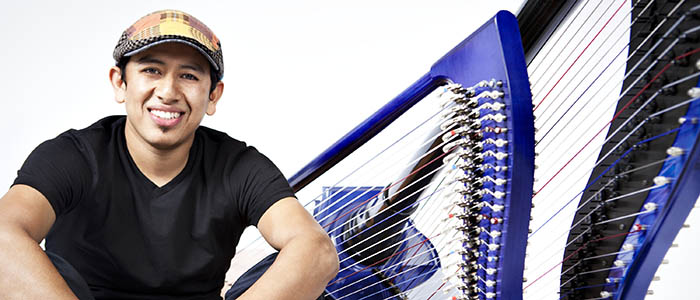Edmar Castaneda Resurrects and Ignites the Harp at The Clarice
This blog post is by Karla Casique, a sophomore journalism major.

The Venezuelan llanos stretched out before me, painted in a nostalgic haze, the land pulsing and blurring with each pluck of the harp, every coax of Edmar Castaneda’s fingers causing memories to peel themselves away from the dark closets of my mind and dance before me on the cabaret style theatre on a Friday night.
It was a fascinating thing to watch Castaneda and Tierra perform together, their souls clearly forged from the same stone. It’s not surprising since they are husband and wife—20 days after meeting, they got married and now have 2 kids plus 12 years of marriage. Both have the gift of smudging reality, making the music visible across the air, their passion and devotion vibrating the skeletons of the crowd.
Unpredictable, magical, clothed in the hearts of the lands which he resurrected at his feet, Castaneda’s performance at the Kogod Theatre in The Clarice Smith Performing Arts Center was like a hurried voyage—full of colors, tastes and sounds that teased each other and poured themselves into your lungs.
He didn’t play alone like I expected, but instead was accompanied by three impressive musicians who were gods in their art, mythical creatures brought together by the rich spirit of the harpist that has revolutionized the prized instrument.
Using his left hand as a bass player and his right hand as a guitar or a piano, as he said in his NPR Tiny Desk Concert, it was fascinating to see first-hand how he is transforming the jazz genre and beyond.
Blending Joropo, Colombian folk music, Latin jazz and other genres, the artists plunged with their arms outstretched into the roaring tide, their instruments used to lure the ocean into their worlds.
Soprano saxophone player Shlomi Cohen brought gold onto the canvas of “Cuarto de Colores”, dipping low and flying high as sax, harp and percussion by Dave Silliman communicated with each other. All were drunk on the rhythm, their bodies swaying, grins tossed to each other, the audience tapping their feet but their voices silent.
Throughout the piece, the harp would be silent, Edmar cradling it, closed eyes and being guided by Silliman, whom Edmar calls “the man with 4 hands.” Then the sax would perch on its throne while the harp and drums danced and all three gave an elated boom in the end.
Edmar was charismatic and humble, asking how many Colombians were in the crowd. A few cheered, including myself (my mom is from Medellín) and he nodded in enthusiasm saying, “I asked the same thing in Poland and there was no one.”
Another Medellín native was Andrea Tierra, the vocalist who glided onto the stage and took the microphone like a lifeline. As she sang, her features twisted into something that could only be described as an infinite sorrow.
However, as she sang with her deep alto voice, you came to understand that it wasn’t pain but instead that Tierra has the ability to tap into the veins of the music. As she sang “Carrao Carrao”, a Venezuelan song about a woman who has lost her beloved and sends a carrao to find him, she grabbed the skirt of her dress and knelt on the stage, calling across the earth for the lover’s spirit.
It was a fascinating thing to watch Castaneda and Tierra perform together, their souls clearly forged from the same stone. It’s not surprising since they are husband and wife—20 days after meeting, they got married and now have 2 kids plus 12 years of marriage. Both have the gift of smudging reality, making the music visible across the air, their passion and devotion vibrating the skeletons of the crowd.
“Jesus de Nazareth” revealed Castaneda’s sun, his steady compass. “This is how I pray,” the Bogotá native said before playing. He continued saying that if it weren’t for Christ, he wouldn’t have this gift, and be able to praise Him.
His entire body was bowed, the stage empty except for him and the crowd’s eyes pinned to the flurry of his hands.
Slow, patient and deeply personal, Edmar rubbed and plucked the strings as he tilted his face to the ceiling and muttering “Señor, Señor,” stomping his foot, calling upon God to hear his plea.
The piece ended with an “amen” and Castaneda turned his back to wipe away his tears, but the core of him had already been exposed, sewn gently onto the collars of the witnesses.
A different breed of musician, one whose hands don’t tell him what they’re doing until the act is unfolding, it is astonishing that Edmar Castaneda’s name hasn’t been carved into every museum or art center. He’s a sculptor, one whose vision is caged in marble and can only be freed by the unpredictability of his touch.
